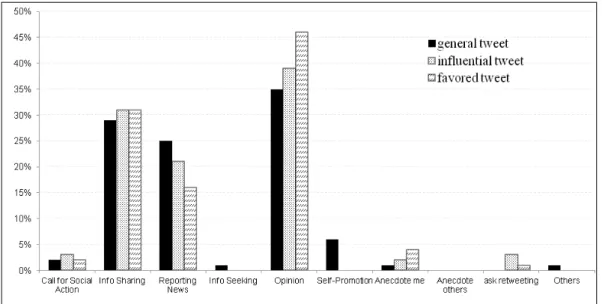트위터 상의 이미지 이용에 관한 분석
EunKyung Chung (정은경)*
JungWon Yoon (윤정원)**
ABSTRACT
Given the context that users are actively using social media with multimedia embedded information, the purpose of this study is to demonstrate how images are used within Twitter messages, especially in influential and favorited messages. In order to achieve the purpose of this study, the top 200 influential and favorited messages with images were selected out of 1,589 tweets related to “Boston bombing” in April 2013. The characteristics of the message, image use, and user are analyzed and compared. Two phases of the analysis were conducted on three data sets containing the top 200 influential messages, top 200 favorited messages, and general messages. In the first phase, coding schemes have been developed for conducting three categorical analyses: (1) categorization of tweets, (2) categorization of image use, and (3) categorization of users. The three data sets were then coded using the coding schemes. In the second phase, comparison analyses were conducted among influential, favorited, and general tweets in terms of tweet type, image use, and user. While messages expressing opinion were found to be most favorited, the messages that shared information were recognized as most influential to users. On the other hand, as only four image uses - information dissemination, illustration, emotive/persuasive, and information processing - were found in this data set, the primary image use is likely to be data-driven rather than object-driven. From the perspective of users, the user types such as government, celebrity, and photo-sharing sites were found to be favorited and influential. An improved understanding of how users’ image needs, in the context of social media, contribute to the body of knowledge of image needs. This study will also provide valuable insight into practical designs and implications of image retrieval systems or services.
초 록
이용자들은 최근 소셜 미디어를 활발하게 이용하고 있으며, 소셜 미디어는 이미지와 같은 멀티미디어 정보의 배태가 주요한 특징이다. 본 연구는 트위터 상에서 이미지 이용 행태를 규명하고자 하였다. 이를 위하여 2013년 4월에 발생한
“보스턴 마라톤 대회 테러” 사건과 관련된 1,589건의 이미지 포함 트윗 메시지를 수집하여 이 중에서 영향력 있는 트윗 메시지 200건과 선호하는(favorite) 트윗 메시지 200건, 무작위로 선택된 일반 트윗 메시지 200건을 각각 선정하여 데이터 분석을 실시하였다. 데이터 분석은 두 단계의 분석과정과 세 그룹의 데이터 셋을 대상으로 수행하였다. 첫 번째 단계에서는 기존 선행연구를 바탕으로 개발된 코딩 체계를 활용하여 세 그룹의 데이터에 대해서 트윗 메시지, 이미지 이용, 이용자에 관하여 각각 수행되었다. 두 번째 단계는 세 그룹의 데이터 셋(일반 트윗, 영향력 있는 트윗, 선호하는 트윗)의 코딩 결과를 비교 분석하였다. 이러한 분석과정을 통해서, 의견을 표현하는 트윗이 가장 선호되었으며, 정보를 공유하는 트윗이 가장 영향력이 있는 것으로 나타났다. 이미지 이용 관점에서는 정보배포, 일러스트레이션, 감정적/설득적, 정보처리 이용목적이 가장 두드러지게 나타났다. 이러한 이미지 이용은 기존의 이미지 이용 패턴과 달리 이미지를 데이터로서 이용하는 목적이 객체 중심으로 이용하는 목적보다 높은 것으로 나타났다. 이용자 분석에서는 정부기관, 유명인, 이미지 사이트가 가장 선호되고 영향력 있는 것으로 나타났다. 이러한 연구결과는 이용 맥락 관점의 차세대 이미지 정보 검색 패러다임을 위한 이용자 관점의 이해 증진에 기여할 수 있을 것으로 기대한다.
키워드: Image Retrieval, Image Needs, Image Use, Context, Social Media, Twitter, Information Dissemination 이미지 검색, 이미지 정보요구, 이미지 이용, 맥락, 소셜 미디어, 트위터, 정보배포
